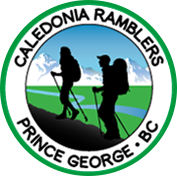For any winter trip on snowshoes that travels through avalanche terrain, participants need to have avalanche gear (beacon, shovel and probe) and know how to use it. The avalanche beacon must be digital and multi-antenna. AST1 is highly recommended. You do not need the gear (or the training) if you are NOT travelling in avalanche terrain.
Trip Leader Guidelines for Winter Trips
Trip leaders are organizers, not trained guides. As such, trip leaders are familiar with the trail head and the route. In the field, the trip leader should make sure that all participants are comfortable with the route as the group is navigating the terrain. Route and turn-around decisions should be made by the group as a whole.
Prior to the trip, the Trip Leader should determine whether participants are likely to encounter avalanche prone terrain. In making the determination, the Trip Leader should check pertinent weather forecasts, and Avalanche Canada forecasted conditions.
To assist with the trip planning, use:
The Avalanche Canada Avaluator card) and Trip Planner. If conditions on the ground on the day of the trip are such that the trip is not recommended in the Trip Leader's judgment, the Trip Leader must relocate or reschedule the trip.
If the Trip Leader determines that travelling in avalanche prone terrain is likely and that such terrain cannot easily be circumvented or otherwise avoided, in that event:
- Every participant must carry, have practised with, and be proficient in the use of a digital avalanche beacon, probe, and shovel (“Avalanche Equipment”), and
- At the trailhead, the Trip Leader must complete a beacon check.
However, if the Trip Leader determines participants can divert to a different course, or circumvent or otherwise avoid the avalanche prone terrain, then and in that event, the participants do not need to carry Avalanche Equipment.
Participant Responsibilities for Winter Trips
Ensure you have the equipment and appropriate clothing required for the planned trip. If the trip organizer requires that participants bring avalanche equipment:
- Bring a beacon, shovel and probe, and know how to use them.
- Make sure that your beacon alkaline batteries are still good for at least another day’s use, and carry spares. Be familiar with any battery guidelines that came with the beacon. Note that user-replaceable rechargeable batteries are NOT an option for avalanche beacons. For more information on this read this post from Alpine Accents International.
- If you have a GPS or Navigation app on your phone, and an Avaluator Card, bring them along.
- The night before the trip, check the avalanche and weather forecast from Avalanche Canada so that you can be an informed group member.
Beacon Requirements
Digital, 457 kHz three-antenna beacon models are required.
Recommended Avalanche Training Course Avalanche Skills Level 1 (AST 1)
An AST 1 course is your place to start. While you do not need any experience to take this course, it is a must for everyone recreating in the backcountry or slack country, as you will learn how to recognize avalanche terrain and how to rescue a companion. An AST 1 is a minimum of two days with both classroom and field components. AST 1 is a prerequisite for other avalanche safety courses and is only the beginning; avalanche pros will tell you; avalanche training is a life-long process.
As an added note, Avalanche Canada has posted a series of webinars on avalanche that is recommended viewing.
As well, Craig and Bonnie at Dezaiko Alpine Adventures are offering courses on how to avoid getting caught in an avalanche and what to do in the unfortunate event that your group is caught in one. It is a recommended course if you would like to get some avalanche training.
